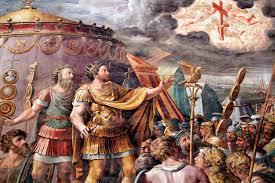THE CONSEQUENCES OF CONSTANT CONVERSION
Consequences of the conversion of Constantine.
Christianity having become the official religion of the state, the pagans entered in mass in the Church following the Emperor, but without being really converted. They brought with them idols, habits, erroneous, rude, superstitious practices. Consequently, the Christian Church soon lost its purity and its fidelity. On the other hand, the prolonged contact with the barbarian peoples who invaded the Roman Empire also diminished its spirituality.
We witness during this period the formation of Roman Catholicism which manifests this deviation from the Christian religion and appears to us as unfaithful to Jesus Christ and to the early Church.
The Clergy, dedicated to celibacy, forming a completely separate caste, governs the laity and becomes the necessary intermediary between God and men. The bishops of Rome, under the name of popes. want to dominate the civil power (Gregory VII, Innocent IlI, Boniface VIII) and sovereignly lead the whole Church.
While admitting the supremacy of the pope, the Catholic Church recognized the authorized sovereign of the councils until 1810. One of the most famous is the Council of Trent ((541). But the Councils were rarely convened and They were suppressed in principle and in fact by the Vatican Council (1810) which decreed the infallibility of the pope.
On several occasions, the pontifical throne is occupied by unworthy popes who only increase the disorder of the Church (the Borgia. The claims of the papacy provoked the schism of the East. The Church of the East, nicknamed Greek or Orthodox was constituted separately under the direction of the Patriarch of Constantinople, rival of the Pope of Rome (1054).
Catholic doctrines or dogmas are promulgated by Councils and imposed on the faithful who have no right to discuss them. Several of these subtle doctrines wanting to explain the inexplicable (Trinite, two natures of Christ). Erroneous or formed of coarse representations (personality of the devil, purgatory, assumption of the Virgin, transubstantiation, magic action of the sacraments, compulsory confession, indulgences, absolute authority of the priest, etc.) are the opposite of principles so simple, so alive and so deeply religious of Jesus Christ.
NB: I do not however claim that all the dogmas of Catholicism are all devoid of spiritual truths. Those who deviate from these doctrines reputed to be only Orthodox are declared heretics, excommunicated and persecuted without mercy.
The cult takes on pompous forms (candle altars, richly decorated altars and chapels, priestly vestments). Celebrated in Latin, in a language that the people soon understand, it takes more and more a liturgical, ritual and superstitious turn. We begin to venerate images, statues, relics; pilgrimages are instituted; we multiply the festivals. Prayer turns into mechanical recitation (rosary litanies). The preaching is abandoned and finally suppressed. Instead of worshiping God, we prefer to address the Virgin and the Saints, who are considered more accessible. The worship is concentrated especially in the Mass which takes a great importance, because of the miraculous character given to the sacrament.
Under the pagan influence, the Last Supper, a symbolic ceremony at the outset, materialized and ended up taking on a purely magical character. The Communion wine, taken from the laity, the bread, replaced by the host are supposed to, after the liturgical ceremony performed by the priest, to truly become the body and blood of Jesus- Christ (transubstantiation). This sacrifice of Christ, supposedly performed again on the altar (Eucharist), becomes the center of worship. It is believed that the mass said for the benefit of such and such a person, can serve to atone for the sins of the living and also to free the souls held in purgatory. The baptism, given to small children, is supposed tolever original sin and is therefore regarded as necessary for salvation.
Five other Sacraments are added to Baptism and the Eucharist: Continuation, la Penance, Extreme anointing, ordination (of priests), Marriage.
The Middle Ages believed that the Christian ideal was represented by the monastic ideal. Hence two morals: one, superior, practiced by priests and especially by monks; the other, lower, for the use of the laity. The Church imagines that those who practice higher morality do more than their duty (supererogatory works) and acquire merits which it reverses on the simple faithful, in the form of indulgences.
Salvation becomes a matter of calculation and trade. The practice of external devotions replaces the faith of the heart.
If the fear of hell terrorizes consciences, formalism puts them to sleep, and ignorance makes souls servile and superstitious. Pure, disinterested evangelical morality, with its demands and its holy joys, vanishes.
During this period, the Catholic Church counted some big names. In the Greek world: Eusèbe (270-340), Athanase (296.373), Jean Chrysostôme (347-407). Let's give the Latin world: Jérôme (331-420), Ambroise (340-397) and especially Saint-Augustin (354-430). Later it should be noted: Alcuin (735.804), Jean Scot Erigène (9th century): Anselme de Cantorbéry (1033-1109), Abélard (1079-1142), Saint François d'Assise (1182-12261), Thomas Aquinas (1226-1274).
It is fair to recognize that the Catholic Church has tried to discipline the barbarian peoples. She also opened schools. inspired the Crusades, elevated magnificent cathedrals (Byzantine, Romanesque, Gothic arts). She wanted to soften feudal mores (Truce of God, Chivalry).
The Church sees men and groups of men rise up against it who denounce its errors and abuses. All rely on the Bible which is both their spiritual nourishment and their defense. The Albigensians in the South of France, the Poor in Lyon, with their leader Pierre Valdo, the Vaudols in the Alps of Piedmont and Dauphiné, form religious movements repressed by iron and fire. There were also individual protests: Jean Wiclef (1324-1384) in England, Jean Russ and Jérôme de Prague in Bohemia, both burned in Constance, one in 1415, the other in 1416. - Savonarola, in Italy, burned in Florence, in 1498.
what people say to look up







After reading this article, I realize that the whole church needs another reform